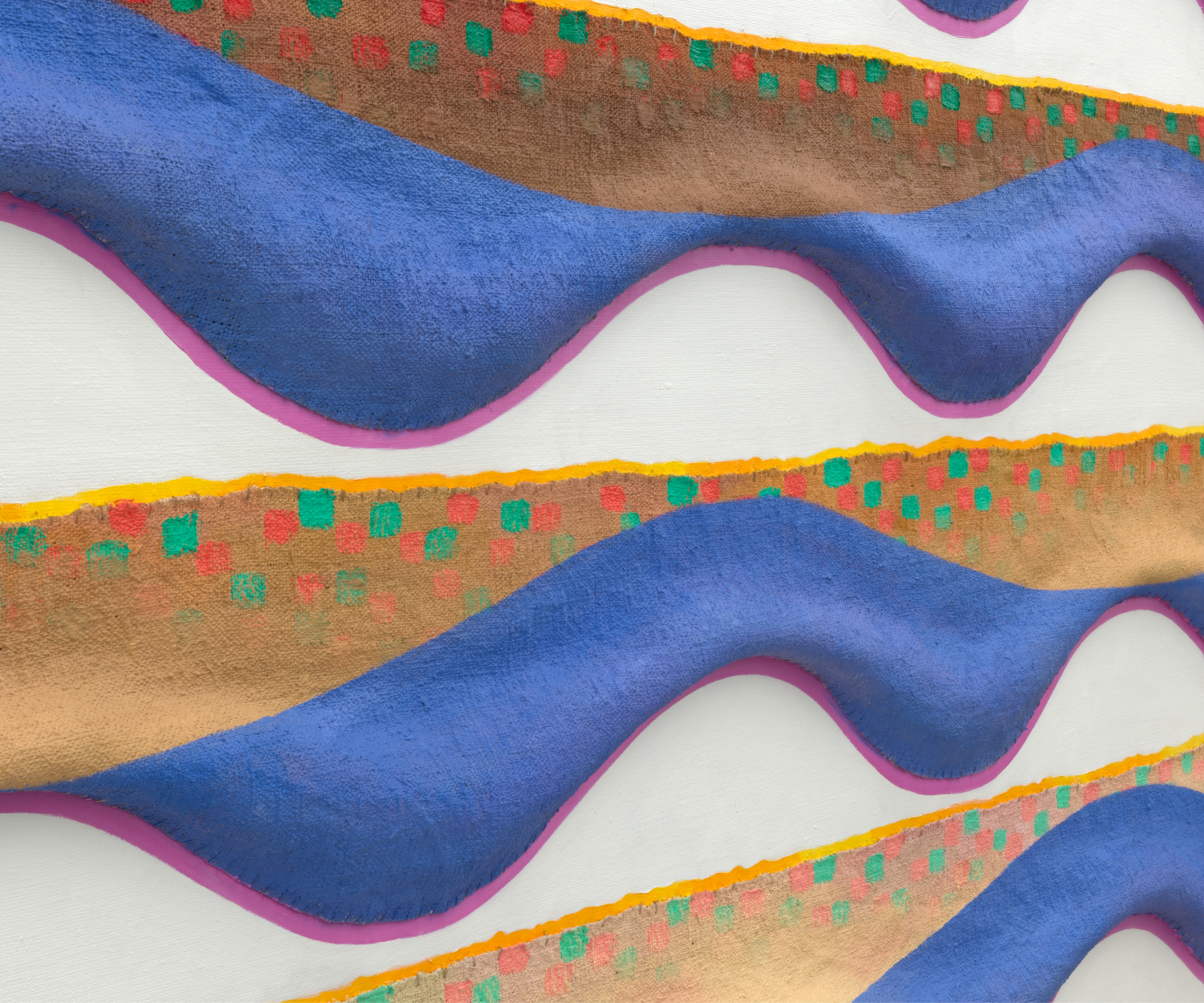→ PAST
EXHIBITION
Ilona Keserü:
Flow
Curator:
Mónika Zsikla, PhD
Exhibition Research Consultant
Monograph Co-Editor:
Agata Jakubowska
13 December 2024 – 11 May 2025
Hosted by Muzeum Susch, the retrospective Ilona Keserü: Flow showcases the works of one of Hungary’s foremost abstract artists, with an exhibition that looks to explore the recurring motifs and themes that have defined Keserü’s distinctive approach to art for more than 70 years.
In Keserü's body of work trajectories of modern European art are combined with references to Baroque architecture and to Hungarian folk culture. Among the artists who have profoundly influenced her outlook, Keserü highlights Maria Jarema, Alberto Burri, Lucio Fontana, and Cy Twombly. Her artistic vision remains deeply informed also by folkloristic motives and textiles, particularly the rustic underskirts she purchased in the market of her hometown of Pécs.

A year-long sojourn in Italy (1962) began a fascination with Italian architecture, which led to the creation of Keserü’s first important paintings. Considered as entry to the artist’s mature phase, these works rejected figural visual representation in favour of abstraction. In 1967, the artist discovered the heart-shaped late-Baroque tombstones in the Balatonudvari Cemetery, recognising in them the ‘image of her most instinctive hand gesture.’ This moment of inspiration and clarity would lead to a wave motif, arc-threaded through its middle, that became central to Keserü’s artistic practice. Another recurring motif is the ‘tangle,’ which can also be regarded as one of the central metaphors of her oeuvre.
The late 1960s were a time of intense experimentation for Keserü, during which she began to explore different materials and techniques. This was when themes of female identity were emphasised in her art, independently of the simultaneously emerging “second wave” of feminism. She was among the first of her generation to use sewing, not as a mere craft but as yet another means of artistic expression. Creating textile reliefs, Keserü developed a canvas-embossing technique that would become her trademark.

Colour has traditionally played a pivotal role in Keserü’s practice. Indeed, the artist’s use of bright, vibrant hues has been underpinned by her studies on the relationship between the colours of human skin and the colours of the rainbow. She has also elaborated on other aspects of rainbow colours, sometimes combining them with linguistic elements; or referring to the presence of participants. In 1987, Keserü’s interest in the “Möbius strip” allowed her to connect an infinite sequence of colours with spatial forms. Another turning point in her decades-long colour research came in 2001, when, following her second residency in Rome, she found herself drawn to the Renaissance technique of cangiante, which she drew upon for her transposition of musical sound into visual forms.

Celebrating her 91st birthday this year, Ilona Keserü continues to work with undiminished power. The final room of the exhibition showcases the artist's latest works, which offer a powerful perspective on the retrospective as a whole.
Ilona Keserü was born in 1933 in Pécs, Hungary. She graduated from the Academy of Fine Art in Budapest in 1958 (the István Szőnyi fresco painting studio). She started exhibiting her art in the mid-1960s and participated in the important exhibitions that formed the so-called Iparterv generation. In parallel, she began developing her career as a theatre designer. From 1983, she taught at the University of Pécs and then became one of the founders of the Master School of Fine Arts in Pécs. Keserü has received several significant Hungarian cultural prizes. Recently, her works have been included in exhibitions featuring the world’s most important abstract artists (e.g. Epic Abstraction: Pollock to Herrera, The Metropolitan Museum of Art, New York, 2019. Women in Abstraction, Center Pompidou, Paris, 2021).
Mónika Zsikla is an art historian and curator. She studied Art History and Aesthetics at the Pázmány Péter Catholic University and continued her education in the Aesthetics Program of the Doctoral School of Philosophy at Eötvös Loránd University, where she received her PhD degree in 2024 with a thesis about the theories of monochrome painting. Between 2007 and 2015, Zsikla worked as artistic director at Kisterem Gallery in Budapest, whereas from 2017 to 2020 she was curator at the Budapest Gallery. In the years 2020 to 2024, she served as the curatorial director of Q Contemporary, Budapest. Since 2017, Zsikla has been a lecturer at the Moholy-Nagy University of Art and Design. Over the past decade, she has curated and co-curated numerous exhibitions of Hungarian and international contemporary art. Zsikla’s recent curatorial projects include: Zsófia Keresztes – After Dreams: I Dare to Defy The Damage (Hungarian Pavilion, 59th Venice Biennale in 2022), Ilona Keserü: All (Q Contemporary, 2023), Dóra Maurer: The Thematisation of Structure (Vaszary Gallery, Balatonfüred, 2023–2024), László Fehér: Capturing Memory (Q Contemporary, 2023), Mediating Time and Charm (Q Contemporary, 2023), The Image of Colour, the Mystery of Image (MODEM, Debrecen, 2024). She is a member of the AICA.
Agata Jakubowska is a professor of art history at the University of Warsaw and the author and editor of numerous publications on women's art. Recently, she published Horizontal Art History and Beyond. Revisioning Peripheral Critical Practices (ed. with Magdalena Radomska, Routledge 2022), a monograph on Polish sculptor Maria Pinińska-Bereś under the title Art and Emancipation of Women in Socialist Poland. The Case of Maria Pinińska-Bereś (in Polish, Warsaw University Press, 2022) and an IKONOTHEKA issue titled Feminist Art Historiographies in Eastern Europe and Latin America (33/2023, ed. with Andrea Giunta). Currently, Jakubowska is researching the transnational history of all-women exhibitions (funded by the Polish National Science Center). Within the framework of this project, she is preparing a book, Real and Imagined Communities in All-Women Exhibitions. She is a member of the editorial team of Avant-Garde Critical Studies (Brill) and of the international TEAM (Teaching, E-learning, Agency, Mentoring) initiative led by AWARE (Archives of Women Artists Research & Exhibitions).
International press:
Sutton Comms, London| E: ginevra@suttoncomms.com| T: +44 (0)7809 901890